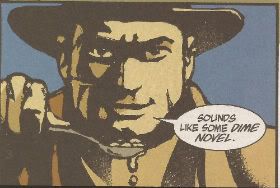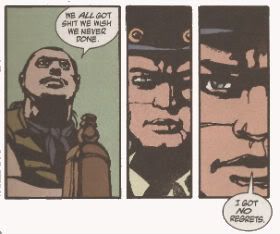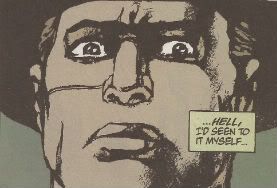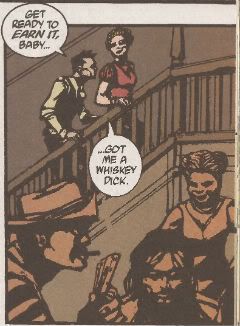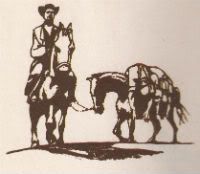"...only a fool goes huntin' GHOSTS." Comics! Sometimes They Judge You!
/So, yeah, I read something and then I went and wrote about it all half-assed like and if you aren't doing the chores you might want to hunker down a spell and take a look. Might not as well. Ain't no skin off mine.
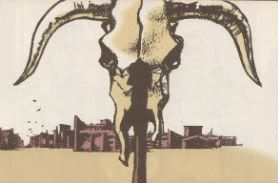
Ah, there's just nothing like a merciless black-hearted look at human nature to lift your spirits is there? EL DIABLO By Danijel Zezelj (a), Brian Azzarello (w), Kevin Sommers (c), Clem Robbins (l) and Tim Sale (covers) Vertigo/DC Comics, $12.99
The peace in Bollas Raton is kept by Sheriff Moses Stone. Stone was a mean man once upon a poisoned water hole, a bounty hunter by trade, but now he's turned his back on the whole sorry man hunting deal. These days he's a good man, with a good wife in a good town. Enter El Diablo! The peace of the town is shattered, men die, flesh is scarred and Moses Stone leads a posse after El Diablo into the badlands towards a town called Halo; where the stage is set for a showdown between The Past and The Present, but identities and alignments shift like the dunes and reckonings for the wrongs of The Past must be paid in full. El Diablo is about to show Moses Stone that a man can have secrets even from himself.
To say any more would spoil the plot as it has a couple of big reveals that to do more than allude to would strip a whole chunk of pleasure out of the book. Sure, one of these reveals requires a pretty big suspension of disbelief but if you aren't willing to go the extra inch on this one while reading about a supernatural incarnation of vengeance then I don’t know. I just don’t know. It’s a fine plot, tight as a nut; one that barrels right along with a convincing cast of characters, crackling and layered dialogue, moments of hideous psychological and physical horror (and indeed both in one darling scene involving an ant hill) and leaves you feeling a bit unsettled and nauseous. Like when your boozy Auntie slipped you the tongue that time.
It’s pretty fitting that I can only lift up my skirts and dance around the content as Azzarello is a very literary writer one whose work can irritate and confound on occasion with its elliptical and stubbornly obtuse approach. He seems to operate on the assumption that his work will be read and re-read, that some effort will be made by the reader to pierce the layers of obfuscation in order to ascertain his true meaning. He seems not to think his comics are just mental screensavers for readers waiting for the menu on their new DVD box set to load up. Which is admirable but intermittently his very specific methodology can work against him to produce comics that are baffling and incoherent. Which is when you end up with a cancery priest fighting a big robot man name after a Peter Shaffer play on a tropical island. Forever. But that doesn't happen here because when he marries it with the right subject the results are delightfully intelligent and reward close attention. El Diablo is one such marriage and you are cordially invited to attend.
El Diablo is soaked in the supernatural and the enemy of effectively conveying the uncanny is specificity. Now, since specificity isn't exactly one of the problems Azzarello has as a writer this works to his advantage here. He manages to stop the sense of the supernatural slipping into nonsense by giving it some ground rules. But he doesn't do it where you’d expect. In the second chapter Moses Stone and his ill-fated posse sit around a camp fire jawing about El Diablo. This allows Azzarello to present the reader with several options regarding the nature of El Diablo. Noah gives the basic outline of the original character (created by Robert Kanigher and Gray Morrow in 1970), Honus sees it as a vengeful force seeking retribution on its own killers, Paw Paw tells of how the Apaches basically view it as a being allocated by The Great Spirit with enacting revenge for the restless dead (I believe that's The Spectre and I believe that's an in-joke.). This is pretty interesting as each man has heard of El Diablo and each man has a different explanation but they can only agree on one thing; you do bad and El Diablo’s gonna even the score. So, while apparently explaining El Diablo to the reader Azzarello has in fact done no such thing but the reader feels that he has.
It’s an even neater piece of misdirection in that the real key to El Diablo’s motivation is presented early in the book during an exchange between Paw Paw and Moses Stone. The two are watching two Indians being hung for the murder of a little girl. Stone reckons they deserve their fate due to their awful crime but Paw Paw, who tracked and caught them, thinks they are innocent of the stated crime but still deserve to swing because they killed his horse. The nature and severity of the transgression isn't important merely the fact that an offence has been committed is enough for the most severe of penalties. There’s also another layer here. Paw Paw’s horse wouldn't have been shot had he not been tracking the Indians. He has basically contributed to event that have resulted in the offenders being, in his eyes, justly rewarded. This is, in actual fact, how El Diablo works on the characters, particularly Moses Stone. Only once does El Diablo directly visit his judgement, when a poor sap foolishly makes fun of him, on all other occasions he herds his victims into situations where their own actions doom them. And since actions are indicative of intent and intent is indicative of character their doom is deserved. In the world of El Diablo good men are just bad men waiting to happen. And when they do happen El Diablo will be there. The best weapon in El Diablo’s arsenal is man’s nature. And man’s nature being what it is, in this book anyway, it’s the only weapon El Diablo really needs.
The atmospheric success of the whole moody enterprise is due in no small part to the magnificently dusty efforts of Danijel Zezelj whose art is, naturally, more European in approach (and origin) than the usual North American Genre Comics artists. His diverse and atypical storytelling sensibilities give the pages an unsettling feel all by themselves and when added to the oblique air Azzarello gives everything succeed in saturating the book in the uncanny so necessary for it to work. The use of overhead shots of scenes give a creepy sense of an omnipresent viewer that works to build the impression that nothing is hidden from El Diablo. Zezelj’s frequent use of overlapping panels makes the characters seem trapped in the book and in the books events, which of course they are. There’s also a lot of blank space within the panels but rather than suggesting freedom and wide open spaces, because they are largely enclosed by strict panel borders, these spaces seem to suggest instead a void; a true and terrible emptiness that everyone in the book is just slightly ahead of. Until, of course, they aren't.
Kevin Somers colours are also noteworthy. Working with a pastelly palette of muted tones applied with few, if any, tonal variations, these colours not only help induce mood but are valuable storytelling tools. Oft times the colour of characters will be used to highlight and centre the reader’s attention on the focal point of a scene. It’s a simple but effective trick that I liked and if the colourist has done something I noted he must be doing a good job because, brothers and sisters, what I know about comic book colouring wouldn't fill a pint pot already half full with piss. The TPB is also really nicely designed by Amelia Grohman. Now this is only a 4 issue series so I guess there’s some padding going on here but if you’re going to pad this is the way to do it. Certain of Zezelj’s images are cropped out of the book and dropped on full pages of colour as spot illos to striking effect and each issue is preceded by a full page consisting of a panel containing significant dialogue blown up to fill a page. Like the colouring it’s simple but effective stuff and worth a shot of old rotgut should I ever meet the individuals involved.
El Diablo is a weird western. A very weird western indeed. It is also Very Good!


